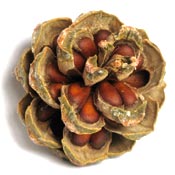The Story of the American Pine Nut Market
The Native American Community which harvests the New Mexico variety traditionally had better access to markets. Before WWII, the trading post systems offered organizational tool to get the P. Edulis or New Mexico pine nuts into the market. After WWII Route 66 traffic ran right through the major rail systems. The Diné and Hopi Nations had an excellent system in place for bringing their harvests to market.
There are a lot of difference between the resources available to the Nations of the Great Basin (Paiutes, Shoshone, Washoe) and those of the Western Platue Region. There were also significantly fewer people in these nations. There were not as many people picking excess pine nuts (those beyond what the people consumed for substance). The Euro culture in these regions were dominated Mormon Settlers, who really did not want much to do with the outside world. There was never a substantial trade system created and there were simply fewer people. A lot of the Great Basin (Nevada) became property of the Federal Government. When I lived there up to 90% of the land was either military or BLM. There was a very long standing disagrement with the Shoshone Nation about land title and tenure. The bottom line was that commercial availability of the Jumbo Soft shelled pine nuts was limited by population centers and transportation routes. Now with the internet and the extensive work done by Goods From The Woods, many people are discovering the difference and are thrilled with the Jumbo Soft Shell Pinon Nuts.
The long and the short of it is, the Pinus Edulis species had a better supply chain and wider distribution. Until the internet came along, there wasn't much of a distribution system for the soft shelled Pinus Monophylla nuts, beyond California, Reno and Mormon population centers. That in a nutshell is why the Pinus Edulis gained a better position in the market than the Pinus Monophylla or Great Basin Pine nut. They are two very different foods.
The P. Edulis (New Mexico, Colorado Plateau Nuts) are rich in oils and taste wonderfully buttery. Their draw back is the hard shell and the amount of work necessary to extract the nut kernel. The P. Monophylla is very large by comparison and has a sweet flavor. It has a soft shell, which can be snapped between the thumb and the forefinger then rolled like a clove of garlic. They roast at a lower temperature for a longer period of time, than the hard shell. Commercially harvested soft shell pine nuts are cleaned with vegetable oil (1/4 cup per 50 lb bag) in a tumbler to remove pine pitch. The commercial harvest is well organized and most nuts that come to market do so via commercial collection methods. In lean harvest years, there are more weekend collectors and some those nuts make it into the distribution chain. A person can look at a pine nut and tell if it was cleaned or not. If it is covered in pine pitch, it wasn't cleaned and will taste of pine. That is just not true of commercially harvested Great Basin soft shells.
Both species of pine nuts are really wonderful. When I am talking to a raw food client or a person who has not had a fresh wild pine nut, we encourage them to purchase P. Monophylla. They cost less and they are easier to shell. Then we, generally provide a free sample of P. Edulis. That way a person discover the difference. It is our experience that people connect with the first pine nut species they consume. We always ask "where did you eat your pine nuts?" That tells us, which pine nut is right for that client.
There also seems to be another cultural factor. People from Asia, especially those from China and Japan, love the jumbo soft shell pine nut. My guess is that it is very similar to the "snow pine nut" in their homeland with a softer shell. People from these regions highly favor the soft shell pine nut, as do raw fooders.
People who sell only P.Edulis are deeply afraid of losing their market to P. Monophylla. We understand that concern but, cannot embrace fear base marketing tactics. It is not a healthy way to do business.These trees, together with their fruits (the pinyon pine nuts) deserved to be honored.




